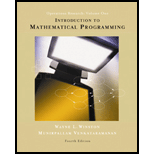
Introduction to mathematical programming
4th Edition
ISBN: 9780534359645
Author: Jeffrey B. Goldberg
Publisher: Cengage Learning
expand_more
expand_more
format_list_bulleted
Concept explainers
Expert Solution & Answer
Chapter 2.3, Problem 7P
Explanation of Solution
Using Gauss-Jordan method to indicate the solutions:
Consider the given system of linear equations,
The augmented matrix of this system is as follows:
The Gauss-Jordan method is applied to find the solutions of the above system of linear equations.
Replace row 3 of A|b by (row 3 + row 2), then the following matrix is obtained,
Now, replace row 1 of
Now, replace row 2 of
Expert Solution & Answer
Want to see the full answer?
Check out a sample textbook solution
Students have asked these similar questions
Find the voltage V0 across the 4K resistor using the mesh method or nodal analysis. Note: I have already simulated it and the value it should give is -1.714V
Resolver por superposicion
Describe three (3) Multiplexing techniques common for fiber optic links
Chapter 2 Solutions
Introduction to mathematical programming
Ch. 2.1 - Prob. 1PCh. 2.1 - Prob. 2PCh. 2.1 - Prob. 3PCh. 2.1 - Prob. 4PCh. 2.1 - Prob. 5PCh. 2.1 - Prob. 6PCh. 2.1 - Prob. 7PCh. 2.2 - Prob. 1PCh. 2.3 - Prob. 1PCh. 2.3 - Prob. 2P
Ch. 2.3 - Prob. 3PCh. 2.3 - Prob. 4PCh. 2.3 - Prob. 5PCh. 2.3 - Prob. 6PCh. 2.3 - Prob. 7PCh. 2.3 - Prob. 8PCh. 2.3 - Prob. 9PCh. 2.4 - Prob. 1PCh. 2.4 - Prob. 2PCh. 2.4 - Prob. 3PCh. 2.4 - Prob. 4PCh. 2.4 - Prob. 5PCh. 2.4 - Prob. 6PCh. 2.4 - Prob. 7PCh. 2.4 - Prob. 8PCh. 2.4 - Prob. 9PCh. 2.5 - Prob. 1PCh. 2.5 - Prob. 2PCh. 2.5 - Prob. 3PCh. 2.5 - Prob. 4PCh. 2.5 - Prob. 5PCh. 2.5 - Prob. 6PCh. 2.5 - Prob. 7PCh. 2.5 - Prob. 8PCh. 2.5 - Prob. 9PCh. 2.5 - Prob. 10PCh. 2.5 - Prob. 11PCh. 2.6 - Prob. 1PCh. 2.6 - Prob. 2PCh. 2.6 - Prob. 3PCh. 2.6 - Prob. 4PCh. 2 - Prob. 1RPCh. 2 - Prob. 2RPCh. 2 - Prob. 3RPCh. 2 - Prob. 4RPCh. 2 - Prob. 5RPCh. 2 - Prob. 6RPCh. 2 - Prob. 7RPCh. 2 - Prob. 8RPCh. 2 - Prob. 9RPCh. 2 - Prob. 10RPCh. 2 - Prob. 11RPCh. 2 - Prob. 12RPCh. 2 - Prob. 13RPCh. 2 - Prob. 14RPCh. 2 - Prob. 15RPCh. 2 - Prob. 16RPCh. 2 - Prob. 17RPCh. 2 - Prob. 18RPCh. 2 - Prob. 19RPCh. 2 - Prob. 20RPCh. 2 - Prob. 21RPCh. 2 - Prob. 22RP
Knowledge Booster
Learn more about
Need a deep-dive on the concept behind this application? Look no further. Learn more about this topic, computer-science and related others by exploring similar questions and additional content below.Similar questions
- Could you help me to know features of the following concepts: - commercial CA - memory integrity - WMI filterarrow_forwardBriefly describe the issues involved in using ATM technology in Local Area Networksarrow_forwardFor this question you will perform two levels of quicksort on an array containing these numbers: 59 41 61 73 43 57 50 13 96 88 42 77 27 95 32 89 In the first blank, enter the array contents after the top level partition. In the second blank, enter the array contents after one more partition of the left-hand subarray resulting from the first partition. In the third blank, enter the array contents after one more partition of the right-hand subarray resulting from the first partition. Print the numbers with a single space between them. Use the algorithm we covered in class, in which the first element of the subarray is the partition value. Question 1 options: Blank # 1 Blank # 2 Blank # 3arrow_forward
- 1. Transform the E-R diagram into a set of relations. Country_of Agent ID Agent H Holds Is_Reponsible_for Consignment Number $ Value May Contain Consignment Transports Container Destination Ф R Goes Off Container Number Size Vessel Voyage Registry Vessel ID Voyage_ID Tonnagearrow_forwardI want to solve 13.2 using matlab please helparrow_forwarda) Show a possible trace of the OSPF algorithm for computing the routing table in Router 2 forthis network.b) Show the messages used by RIP to compute routing tables.arrow_forward
- using r language to answer question 4 Question 4: Obtain a 95% standard normal bootstrap confidence interval, a 95% basic bootstrap confidence interval, and a percentile confidence interval for the ρb12 in Question 3.arrow_forwardusing r language to answer question 4. Question 4: Obtain a 95% standard normal bootstrap confidence interval, a 95% basic bootstrap confidence interval, and a percentile confidence interval for the ρb12 in Question 3.arrow_forwardusing r languagearrow_forward
- using r languagearrow_forwardusing r language Obtain a bootstrap t confidence interval estimate for the correlation statistic in Example 8.2 (law data in bootstrap).arrow_forwardusing r language Compute a jackknife estimate of the bias and the standard error of the correlation statistic in Example 8.2.arrow_forward
arrow_back_ios
SEE MORE QUESTIONS
arrow_forward_ios
Recommended textbooks for you
 C++ for Engineers and ScientistsComputer ScienceISBN:9781133187844Author:Bronson, Gary J.Publisher:Course Technology Ptr
C++ for Engineers and ScientistsComputer ScienceISBN:9781133187844Author:Bronson, Gary J.Publisher:Course Technology Ptr Operations Research : Applications and AlgorithmsComputer ScienceISBN:9780534380588Author:Wayne L. WinstonPublisher:Brooks Cole
Operations Research : Applications and AlgorithmsComputer ScienceISBN:9780534380588Author:Wayne L. WinstonPublisher:Brooks Cole

C++ for Engineers and Scientists
Computer Science
ISBN:9781133187844
Author:Bronson, Gary J.
Publisher:Course Technology Ptr

Operations Research : Applications and Algorithms
Computer Science
ISBN:9780534380588
Author:Wayne L. Winston
Publisher:Brooks Cole